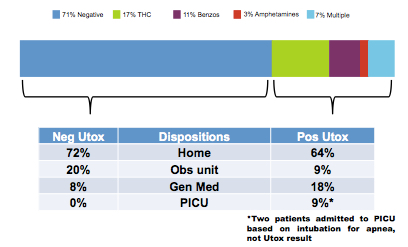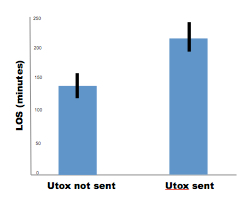Presenting Author:
Irene Hurst, M.D.
Principal Investigator:
Irene Hurst, M.D.
Department:
Pediatrics
Keywords:
Urine toxicology, Lollapalooza, Adolescents, Emergency Medicine
Location:
Ryan Family Atrium, Robert H. Lurie Medical Research Center
C84 - Clinical
Utility of urine toxicology screens in adolescents with alcohol intoxication
Introduction: Urine toxicology panels (UTPs) are commonly used in emergency departments as a screening test for intoxicated patients, but the utility of this test is questionable. They are insensitive, nonspecific and rarely add diagnostic or management value to patient care. Despite this, UTP is commonly sent on intoxicated adolescents who are seen in the Lurie Children’s Hospital pediatric emergency department after attending Lollapalooza. We hypothesize that UTP results do not affect clinical management of patients seen in the emergency department for alcohol intoxication. Objective: To identify if UTPs in intoxicated adolescents alter clinical management. Methods: Patients were identified in the electronic medical record based on age and chief complaint (intoxication) from the dates coinciding with Lollapalooza from 2012 through 2015. Patient information was collected via manual chart review. Results: 424 patients 12 to 18 years old were identified. 332 patients were excluded based on age (162), other chief complaints (colds, asthma, etc., n=159), other differential diagnosis (5), or empty chart (6). 92 patients with chief complaints related to the festival were included, 85 of whom had a chief complaint of intoxication. 68% of patients were female, and average age was 16 years (SD 0.92). Of these patients, 83% had urine toxicology panels sent. 24% of UTPs were positive. Of these positive tests, 21% were positive for THC, 3% positive for benzodiazepines, 7% positive for amphetamines, and 7% had multiple positives. The admission rate was 29%: 16 patients (59%) to an observation unit, 9 patients (33%) to the general inpatient floor, and 2 patients (7%) to the pediatric ICU. The two patients admitted to the PICU with positive UTPs were managed based on clinical deterioration (apnea and desaturations), not due to UTP result. No patients with a negative UTP were admitted to the ICU (p<0.01). Length of stay (LOS) in the pediatric ED was 2:18 h:m (95% CI 20 min) for patients who did not have UTPs sent, but 3:32 h:m (95% CI 17 min) in those who had UTP sent. Conclusions: UTPs were sent on the majority of intoxicated teenage patients seen in the ED after Lollapalooza with a resultant mean increase in ED LOS of more than 1 hour. We did not find evidence that this test impacted clinical management of these patients. As a result, we argue that there is no evidence supporting the utility of UTP for uncomplicated intoxicated adolescent patients.


